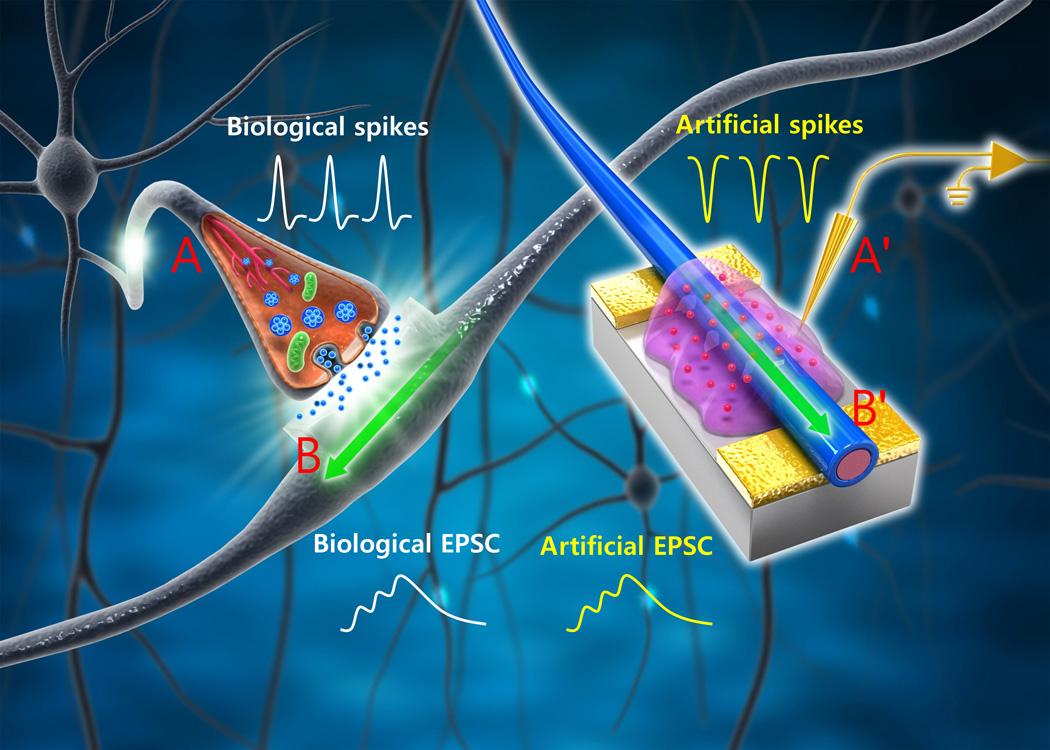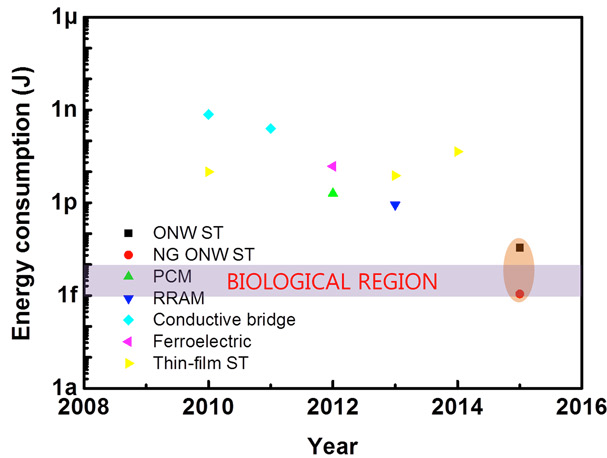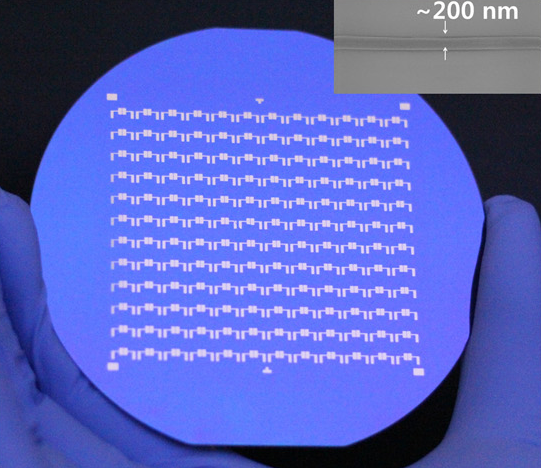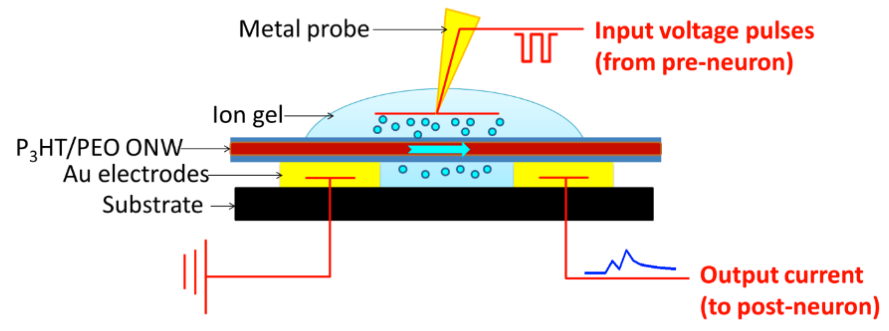Artificial synapse said to rival biological synapses in energy consumption and function
June 27, 2016

Schematic of biological neuronal network and an organic nanowire (ONW) synaptic transistor (ST) that emulates a biological synapse. The yellow conductive lines and probe (A′) mimic an axon (A) that delivers presynaptic spikes from a pre-neuron to the presynaptic membrane. The mobile ions in the ion gel move in the electrical field, analogous to the biological neuron transmitters in the synaptic cleft; the field later induces an excitatory postsynaptic current (EPSC, light blue line) in the biological dendrite (B). An ONW (B′) combined with a drain electrode (yellow surface) mimics a biological dendrite (B). EPSC (light green line) is generated in the ONW in response to presynaptic spikes and is delivered to a post-neuron through connections to the drain electrode. (credit: Wentao Xu et al./Science Advances)
An artificial synapse that emulates a biological synapse while requiring less energy has been developed by Pohang University Of Science & Technology (POSTECH) researchers* in Korea.

Energy consumption in Joules per synaptic event of currently available synaptic devices.*** NG, nanogap; PCM, phase change memory; RRAM, resistive switching random access memory. (credit: Wentao Xu et al./Science Advances)
A human synapse consumes an extremely small amount of energy (~10 fJ or femtojoules** per synaptic event).
The researchers have fabricated an organic nanofiber (ONF), or organic nanowire (ONW), electronic device that emulates the important working principles and energy consumption of biological synapses while requiring only ~1 fJ per synaptic event. The ONW also emulates the morphology (form) of a synapse.

Array of 144 ONW STs (organic nanowire synaptic transistors) fabricated on a 4-inch silicon wafer. Inset: Scanning electron microscopy (SEM) image of a typical ONW with a diameter of 200 nm. (credit: Wentao Xu et al./Science Advances)
The morphology of ONFs is similar to that of nerve fibers, which form crisscrossing grids to enable the high memory density of a human brain. The researchers say the highly-aligned ONFs can be massively produced with precise control over alignment and dimension; and this morphology may make possible the future construction of the high-density memory of a neuromorphic (brain-form-emulating) system.****
The researchers say they have emulated important working principles of a biological synapse, such as paired-pulse facilitation (PPF), short-term plasticity (STP), long-term plasticity (LTP), spike-timing dependent plasticity (STDP), and spike-rate dependent plasticity (SRDP).

The ONW STs are three-terminal devices. Input voltage pulses that emulate presynaptic spikes from a pre-neuron are applied to the metal probe, which functions as a gate electrode. The input pulses cause ions to migrate in the ion gel, causing a change in the source-drain (yellow rectangles) current flowing through the semiconducting ONW (red). The output current signal — which emulates post-synaptic current flowing to a post-neuron in a biological synapse — is measured (during characterization) by recording the drain current. (credit: Wentao Xu et al./Science Advances)
The artificial synapse devices provide a new research direction in neuromorphic electronics and open a new era of organic electronics with high memory density and low energy consumption, the researchers claim. Potential applications include neuromorphic computing systems, AI systems for self-driving cars, analysis of big data, cognitive systems, robot control, medical diagnosis, stock-trading analysis, remote sensing, and other smart human-interactive systems and machines in the future, they suggest.
This research was supported by the Pioneer Research Center Program and Center for Advanced Soft-Electronics as a Global Frontier Project, funded by the Korean Ministry of Science, ICT, and Future Planning.
The research was published an open-access paper in Science Advances, a new sister journal of Science.
* Prof. Tae-Woo Lee, Wentao Xu, and Sung-Yong Min, PhD, with the Dept. of Materials Science and Engineering at POSTECH
** A fJ (femtojoule) is 10-15 Joule (one watt-second).
*** ~1014 synapses.
**** Previous attempts to realize synaptic functions in single electronic devices include resistive random access memory (RRAM), phase change memory (PCM), conductive bridges, and synaptic transistors.
Abstract of Organic core-sheath nanowire artificial synapses with femtojoule energy consumption
Emulation of biological synapses is an important step toward construction of large-scale brain-inspired electronics. Despite remarkable progress in emulating synaptic functions, current synaptic devices still consume energy that is orders of magnitude greater than do biological synapses (~10 fJ per synaptic event). Reduction of energy consumption of artificial synapses remains a difficult challenge. We report organic nanowire (ONW) synaptic transistors (STs) that emulate the important working principles of a biological synapse. The ONWs emulate the morphology of nerve fibers. With a core-sheath–structured ONW active channel and a well-confined 300-nm channel length obtained using ONW lithography, ~1.23 fJ per synaptic event for individual ONW was attained, which rivals that of biological synapses. The ONW STs provide a significant step toward realizing low-energy–consuming artificial intelligent electronics and open new approaches to assembling soft neuromorphic systems with nanometer feature size.